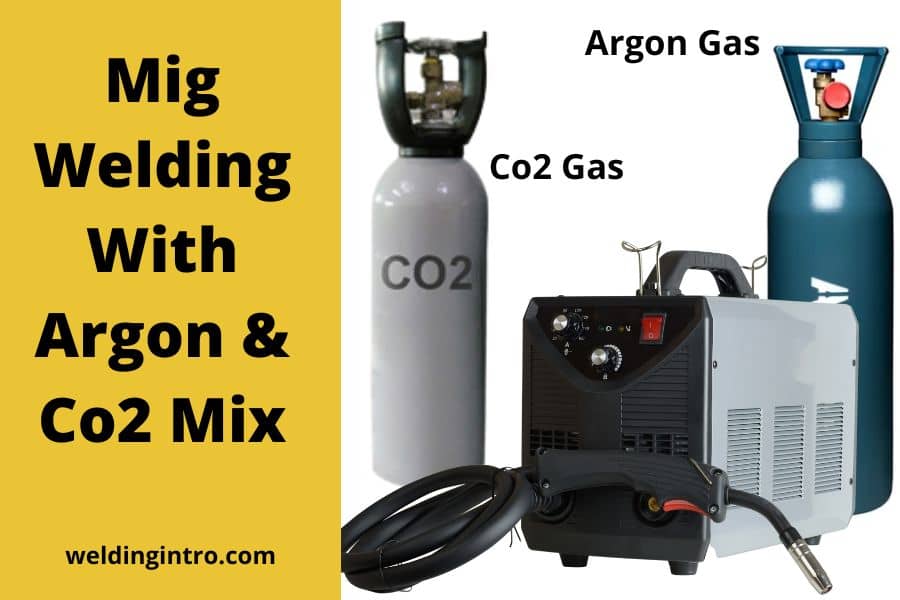Both gas and gasless mig welding techniques are pretty much popular among welders. But for versatility and highest performance, most of the welders prefer gas mig welding. Now if you are planning to mig weld aluminum, what gas would be better?
For aluminum welding, argon & co2 (carbon dioxide) mix is not the better option. For Mig welding aluminum, using argon & co2 mix is not the better option.
Instead you should go for either pure argon or argon-helium mix for mig welding aluminum.

Can You Mig Weld with Argon?
With pure argon you can easily and comfortably weld aluminum. Basically argon is used for mig welding thick aluminum. Argon is the preferred choice for the following reasons
- Oxide Prevention: Aluminum readily forms an oxide layer when exposed to air. Argon provides excellent oxide prevention by creating a stable and protective atmosphere during the welding process. This helps ensure a clean and uncontaminated weld.
- Arc Stability: Argon contributes to a stable welding arc, which is crucial for controlling the heat input and achieving precise welds. The stability of the arc allows for better control of the weld pool and results in high-quality welds.
- Heat Transfer Characteristics: Argon has favorable heat transfer characteristics for aluminum welding. It helps maintain the proper temperature in the weld pool, promoting good penetration and minimizing the risk of defects.
- Reduced Spatter: Argon contributes to reduced spatter during aluminum MIG welding. Spatter, which is the undesirable splattering of molten metal, can be minimized with the use of argon, resulting in cleaner and more efficient welding.
- Versatility and Clean Weld Appearance: Argon is versatile and suitable for various aluminum welding applications. It helps produce clean and aesthetically pleasing weld beads with good bead appearance.
For thinner aluminum, you should use argon and helium mix for better weld.
Can You Mig with Co2 and Argon Mix?
If you go for welding any types of steel, then argon and co2 mix can do the job. The mixture of 75% Argon and 25% Co2 is the best option for Mig welding steel.
Problems Of Using Co2 For Aluminum
Using only CO2 (carbon dioxide) for MIG welding aluminum is generally not recommended. While CO2 is a commonly used shielding gas for welding steel due to its affordability and ability to provide good penetration, it is not well-suited for aluminum welding.
There are several reasons for this:
- Oxidation Issues: CO2 does not provide the same level of oxide protection as argon or argon-based mixtures. Aluminum readily forms an oxide layer when exposed to air, and using CO2 alone may result in increased oxide formation, leading to poor weld quality.
- Arc Stability: Aluminum welding requires a stable arc for precise control of the welding process. CO2 can produce a less stable arc compared to gasses like argon or helium, potentially leading to difficulties in controlling the weld pool and achieving the desired results.
- Spatter and Bead Appearance: Using CO2 as the shielding gas for aluminum can result in increased spatter and a less aesthetically pleasing weld bead appearance. This can impact the overall quality and appearance of the weld.
Can You Weld Without These Gases (Argon & Co2)
Fortunately, Mig welding aluminum without gas is 100% possible if you go with flux-cored shielding wire. Using a bit of flux core wire requires no external gasses at all to get your welding job done.
Hence, aluminum welding turns way easier, portable, and more user-friendly.
A flux-cored wire is an absolute go-to for those who don’t want to mess with any gas like Argon, helium, and co2.
But unfortunately, it has some limitations too, which is why pro welders often rely on gas MIG welding instead of gasless.
What to Consider While Choosing Gas to Mig Weld Aluminum
When choosing a shielding gas for MIG welding aluminum, several factors need to be considered to ensure optimal weld quality and performance. Here are key considerations:
- Oxide Prevention:
- Aluminum readily forms an oxide layer when exposed to air. Choose a shielding gas that provides effective oxide prevention to ensure a clean and contaminant-free weld. Argon is a common choice for this purpose.
- Arc Stability:
- Select a gas that contributes to a stable welding arc. Arc stability is crucial for controlling the heat input, achieving precise welds, and minimizing the risk of defects. Argon is known for providing a stable arc in aluminum welding.
- Penetration and Heat Transfer:
- Consider the penetration and heat transfer characteristics of the gas. The chosen gas should promote good penetration while maintaining the appropriate temperature in the weld pool. Argon, often used alone or in a blend with helium, is favored for its suitable heat transfer properties.
- Spatter Reduction:
- Spatter, the undesirable splattering of molten metal, can be an issue in welding. Choose a gas that helps reduce spatter for cleaner and more efficient welding. Argon is known to contribute to reduced spatter during aluminum MIG welding.
- Application Thickness:
- The thickness of the aluminum material being welded can influence the choice of gas. For thicker sections, a blend of argon and helium may be preferred to enhance heat input and penetration.
- Cost Considerations:
- Evaluate the cost of the shielding gas. While argon is commonly used for MIG welding aluminum due to its effectiveness, it’s essential to consider the overall cost of the gas and its impact on the welding operation.
- Weld Appearance:
- Consider the desired appearance of the weld bead. The chosen gas should contribute to a clean and aesthetically pleasing weld bead. Argon, with its oxide prevention and spatter reduction properties, helps achieve a desirable weld appearance.
- Manufacturer Recommendations:
- Always refer to the recommendations provided by the welding equipment manufacturer. They may specify the optimal shielding gas or gas blend for their equipment and welding processes.
How much argon gas for MIG welding aluminum?
The amount of argon gas required for MIG welding aluminum depends on various factors. The include the welding parameters, the thickness of the aluminum being welded, and the specific welding process.
Here are some general guidelines:
- Flow Rate:
- The typical flow rate of argon gas for MIG welding aluminum is in the range of 20 to 30 cubic feet per hour (CFH) or 9 to 14 liters per minute. This flow rate is a common starting point and may need adjustments based on specific welding conditions.
- Welding Process:
- The welding process used, whether it’s spray transfer, pulse spray, or other variations, can influence the gas flow rate. Refer to the welding equipment manufacturer’s guidelines for recommended settings based on the chosen process.
- Material Thickness:
- Thicker aluminum sections may require higher gas flow rates to ensure proper shielding and penetration. Conversely, thinner materials may require lower flow rates.
- Welding Position:
- The welding position (flat, horizontal, vertical, or overhead) can affect the gas coverage and may influence the optimal flow rate.
- Welding Machine Settings:
- Follow the recommendations provided by the welding machine manufacturer for the specific welding parameters and gas flow rates suitable for aluminum welding.
What is the best gas mix for MIG welding aluminum?
The choice of the best gas mix for MIG welding aluminum depends on the specific requirements of the welding application. While pure argon is a common and effective choice for MIG welding aluminum, certain applications may benefit from gas mixtures.
Here are some common gas mixtures used for MIG welding aluminum:
- Pure Argon (100%):
- Pure argon is frequently used for MIG welding aluminum. It provides excellent oxide prevention, stability in the arc, and spatter reduction. This is a versatile and widely used option for various aluminum welding applications.
- Argon-Helium Mixtures:
- Adding helium to argon creates a blend that enhances heat input and penetration. This can be beneficial for welding thicker aluminum sections where increased heat is required. Common helium percentages in the mix range from 25% to 75%.
- Argon-CO2 Mixtures:
- While not typically recommended for aluminum, some welders use a mix of argon and CO2 for specific applications. This mixture may be suitable for welding aluminum with a spool gun or when dealing with aluminum alloys that have higher levels of magnesium.
Wrapping Up
In conclusion, selecting the appropriate shielding gas is critical for successful MIG welding of aluminum. While argon and CO2 mixtures, commonly used for steel welding, may be cost-effective and readily available, they are not suitable for aluminum welding.
The unique properties of aluminum, including its susceptibility to oxide formation and the need for precise heat control, demand a different approach. Mig welding aluminum with argon & co2 mix is not a good option at all.
